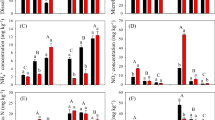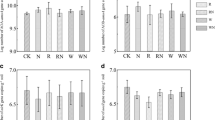Abstract
Background and aims
Waterlogging may affect soil nitrification rates, resulting in changes in plant-available nitrogen (N), and hence potentially influencing crop productivity. Because nitrification is a microbially-driven process and ammonia-oxidizing communities regulate soil nitrification rates, the aim of this study was to investigate the mechanistic response of ammonia-oxidizing communities and nitrification rates to waterlogging.
Methods
A field study was conducted by experimentally imposing two short-term waterlogging events when cotton plants were at the early- and late-flowering stages. Soil physicochemical properties, nitrification rates, and ammonia-oxidizing community abundance and structure in response to waterlogging were examined.
Results
Soil nitrate (NO3−) content, potential nitrification rates (PNR) and the abundance of ammonia-oxidizing communities significantly decreased upon waterlogging. Shifts in ammonia-oxidizing community structure were also observed. Both ammonia-oxidizing bacteria (AOB) and ammonia-oxidizing archaea (AOA) responded to waterlogging. PNR was significantly correlated with the abundance and structure of both AOB and AOA.
Conclusions
Waterlogging had strong negative effects on soil nitrification rates by altering the ammonia-oxidizing community abundance and structure, resulting in reduced soil N availability. Decreased plant-available N is likely to negatively affect primary productivity.




Similar content being viewed by others
References
Bange M, Milroy S, Thongbai P (2004) Growth and yield of cotton in response to waterlogging. Field Crop Res 88:129–142
Bange MP, Baker J, Bauer P, Broughton KJ, Constable G, Luo Q, Osanai Y, Payton P, Tissue DT, Reddy K, Singh BK (2016) Climate change and cotton production in modern farming system. CABI Publication. Book, Boston
Barnard R, Leadley PW, Hungate BA (2005) Global change, nitrification, and denitrification: a review. Glob Biogeochem Cycles 19:GB1007. https://doi.org/10.1029/2004GB002282
Bates DM, Maechler M, Bolker B (2012) lme4: linear mixed-effects models using Eigen and S4. R Package Version 1.1–7. Available online at: http://CRAN.R-project.org/package=lme4
Belser LW (1979) Population ecology of nitrifying bacteria. Annu Rev Microbiol 33:309–333
Bernhard A (2012) The nitrogen cycle: processes, players, and human impacts. Nature Education Knowledge 3(10):25
Braunack M (2013) Cotton farming systems in Australia: factors contributing to changed yield and fibre quality. Crop Pasture Sci 64:834–844
Chen Y, Xu Z, Hu H, Hu Y, Hao Z, Ziang Y, Chen B (2013) Responses of ammonia-oxidizing bacteria and archaea to nitrogen fertilization and precipitation increment in a typical temperate steppe in Inner Mongolia. Appl Soil Ecol 68:36–45
CRC (2010–2011) Cotton catchment communities CRC. Annual report “Cotton CRC campaign assists flooded cotton communities”
Culman SW, Bukowski R, Gauch HG, Cadillo-quiroz H, Buckley DH (2009) T-REX: software for the processing and analysis of T-RFLP data. BMC Bioinforms 10:171
Di H, Cameron K, Shen JP, Winefield C, O’Callaghan M, Bowatte S, He JZ (2009) Nitrification driven by bacteria and not archaea in nitrogen-rich grassland soils. Nat Geosci 2:621–624
Di HJ, Cameron KC, Shen JP, Winefield CS, O'callaghan M, Bowatte S, He JZ (2010) Ammonia-oxidizing bacteria and archaea grow under contrasting soil nitrogen conditions. FEMS Microbiol Ecol 72:386–394
Engelaar WMHG, Bodelier PLE, Laanbroek HJ, Blom CWPM (1991) Nitrification in the rhizosphere of a flooding-resistant and a flooding-non-resistant Rumex species under drained and waterlogged conditions. FEMS Microbiol Ecol 86:33–42
Engelaar W, Symens J, Lannbroek H, Blom C (1995) Preservation of nitrifying capacity and nitrate availability in waterlogged soils by radial oxygen loss from roots of wetland plants. Biol Fertil Soils 20:243–248
Engelaar WM, Mastumaru T, Yoneyama T (2000) Combined effects of soil waterlogging and compaction on rice (Oryza Sativa L.) growth, soil aeration, soil N transformations and 15N discrimination. Biol Fertil Soils 32:484–493
Gieseke A, Tarre S, Green M, De Beer D (2006) Nitrification in a biofilm at low pH values: role of in situ microenvironments and acid tolerance. Appl Environ Microbiol 72:4283–4292
Gleeson DB, Müller C, Banerjee S, Ma W, Siciliano SD, Murphy DV (2010) Response of ammonia oxidizing archaea and bacteria to changing water filled pore space. Soil Biol Biochem 42:1888–1891
Greenway H, Armstrong W, Colmer TD (2006) Conditions leading to high CO2 (>5 kPa) in waterlogged–flooded soils and possible effects on root growth and metabolism. Ann Bot 98:9–32
Gubry-Rangin C, Hai B, Quince C, Engel M, Thomson BC, James P, Schloter M, Griffiths RI, Prosser JI, Nicol GW (2011) Niche specialization of terrestrial archaeal ammonia oxidizers. Proc Natl Acad Sci U S A 108:21206–21211
Hai B, Diallo NH, Sall S, Haesler F, Schauss K, Bonzi M, Assigbetse K, Chotte JL, Munch JC, Schloter M (2009) Quantification of key genes steering the microbial nitrogen cycle in the rhizosphere of sorghum cultivars in tropical agroecosystems. Appl Environ Microbiol 75:4993–5000
Hallin S, Jones CM, Schloter M, Philippot L (2009) Relationship between N-cycling communities and ecosystem functioning in a 50-year-old fertilization experiment. ISME J 3:597–605
Head L, Adams M, McGregor HV, Toole S (2014) Climate change and Australia. WIREs, Climate Change 5:175–197
Hirsch PR, Mauchline TH (2005) Chapter two – the importance of the microbial N cycle in soil for crop plant nutrition. Adv Appl Microbiol 93:45–71
Hodgson A, Chan K (1982) The effect of short-term waterlogging during furrow irrigation of cotton in a cracking grey clay. Crop Pasture Sci 33:109–116
Hu HW, Zhang LM, Dai Y, Di HJ, He JZ (2013) pH-dependent distribution of soil ammonia oxidizers across a large geographical scale as revealed by high-throughput pyrosequencing. J Soils Sediments 13:1439–1449
Hu HW, Macdonald CA, Trivedi P, Holmes B, Bodrossy L, He JZ, Singh BK (2015) Water addition regulates the metabolic activity of ammonia oxidizers responding to environmental perturbations in dry subhumid ecosystems. Environ Microbiol 17:444–461
Jackson MB, Drew MC (1984) Effects of flooding on growth and metabolism of herbaceous plants. Flooding Plant Growth 1:47–128
Kandeler E, Böhm KE (1996) Temporal dynamics of microbial biomass, xylanase activity, N-mineralisation and potential nitrification in different tillage systems. Appl Soil Ecol 4:181–191
Keeney D, Nelson D (1982) Nitrogen - inorganic forms. Method of soil analysis. Part 2. Chemical and microbiological properties. Agronomy 9:643–698
Könneke M, Bernhard AE, José R, Walker CB, Waterbury JB, Stahl DA (2005) Isolation of an autotrophic ammonia-oxidizing marine archaeon. Nature, 437:543–546
Laanbroek HJ (1990) Bacterial cycling of minerals that affect plant growth in waterlogged soils: a review. Aquat Bot 38:109–125
Leininger S, Urich T, Schloter M, Schwark L, Qi J, Nicol G, Prosser J, Schuster S, Schleper C (2006) Archaea predominate among ammonia-oxidizing prokaryotes in soils. Nature 442:806–809
Liu YR, Delgado-Baquerizo M, Trivedi P, He JZ, Singh BK (2016) Species identity of biocrust-forming lichens drives the response of soil nitrogen cycle to altered precipitation frequency and nitrogen amendment. Soil Biol Biochem 96:128–136
Long A, Heitman J, Tobias C, Philips R, Song B (2013) Co-occurring anammox, denitrification, and codenitrification in agricultural soils. Appl Environ Microbiol 79:168–176
Lu S, Tang C, Rengel Z (2004) Combined effects of waterlogging and salinity on electrochemistry, water-soluble cations and water dispersible clay in soils with various salinity levels. Plant Soil 264:231–245
McCauley A, Jones C, Jacobsen J (2009) Soil pH and organic matter. Nutrient Management Module 8:1–12
Milroy SP, Bange MP, Thongbai P (2009) Cotton leaf nutrient concentrations in response to waterlogging under field conditions. Field Crop Res 113:246–255
Nicol GW, Leininger S, Schleper C, Prosser JI (2008) The influence of soil pH on the diversity, abundance and transcriptional activity of ammonia oxidizing archaea and bacteria. Environ Microbiol 10:2966–2978
Northcote KH, Hubble G, Isbell R, Thompson C, Bettenay E (1975) A description of Australian soils. Melbourne, CSIRO
Offre P, Kerou M, Spang A, Schleper C (2014) Variability of the transporter gene complement in ammonia-oxidizing archaea. Trends Microbiol 22:665–675
Patrick WH, Reddy KR (1976) Nitrification-denitrification reactions in flooded soils and water bottoms: dependence on oxygen supply and ammonium diffusion. J Environ Qual 5:469–472
Reddy KR and Patrick WH (1975) Effect of alternate aerobic and anaerobic conditions on redox potential, organic matter decomposition and nitrogen loss in a flooded soil. Soil Biol Biochem 7:87–94
Rochester I, Constable G (2015) Improvements in nutrient uptake and nutrient use-efficiency in cotton cultivars released between 1973 and 2006. Field Crop Res 173:14–21
Rochester I, Constable G, Macleod D (1993) Cycling of fertilizer and cotton crop residue nitrogen. Soil Res 31:597–609
Rochester I, Gaynor H, Constable G, Saffigna P (1994) Etridiazole may conserve applied nitrogen and increase yield of irrigated cotton. Soil Res 32:1287–1300
Rotthauwe JH, Witzel KP, Liesack W (1997) The ammonia monooxygenase structural gene amoA as a functional marker: molecular fine-scale analysis of natural ammonia-oxidizing populations. Appl Environ Microbiol 63:4704–4712
Sahay R (1989) Photosynthetic and stomatal responses of cotton to drought stress and waterlogging. Agric Sci Dig 9:198–200
Schimel J, Balser TC, Wallenstein M (2007) Microbial stress-response physiology and its implications for ecosystem function. Ecology 88:1386–1394
Singh BK, Bardgett RD, Smith P, Reay DS (2010) Microorganisms and climate change: terrestrial feedbacks and mitigation options. Nat Rev Microbiol 8:779–790
Sterngren AE, Hallin S, Bengtson P (2015) Archaeal ammonia oxidizers dominate in numbers, but bacteria drive gross nitrification in N-amended grassland soil. Front Microbiol 6:1350
Szukics U, Hackl E, Zechmeister-Boltenstern S, Sessitsch A (2012) Rapid and dissimilar response of ammonia oxidizing archaea and bacteria to nitrogen and water amendment in two temperate forest soils. Microbiol Res 167:103–109
Tourna M, Freitag TE, Nicol GW, Prosser JI (2008) Growth, activity and temperature responses of ammonia-oxidizing archaea and bacteria in soil microcosms. Environ Microbiol 10:1357–1364
Van Schreven D, Sieben W (1972) The effect of storage of soils under water-logged conditions upon subsequent mineralization of nitrogen, nitrification and fixation of ammonia. Plant Soil 37:245–253
Wang FL, Bettany JR (1994) Organic and inorganic nitrogen leaching from incubated soils subjected to freeze-thaw and flooding conditions. Can J Soil Sci 74:201–206
Xia W, Zhang C, Zeng X, Feng Y, Weng J, Lin X, Zhu J, Xiong Z, Xu J, Cai Z (2011) Autotrophic growth of nitrifying community in an agricultural soil. ISME J 5:1226–1236
Yao H, Gao Y, Nico GW, Campbell CD, Prosser JI, Zhang L, Han W, Singh BK (2011) Links between ammonia oxidizer community structure, abundance, and nitrification potential in acidic soils. Appl Envrion Microbiol 77:4618–4625
Zhang LM, Hu HW, Shen JP, He JZ (2012) Ammonia-Oxidizing Archaea have more important role than ammonia-oxidizing bacteria in ammonia oxidation of strongly acidic soils. ISME J 6:1032–1045
Acknowledgments
We thank Dr. Hangwei Hu at the University of Melbourne, for providing supportive materials for TRFLP analysis. We acknowledge Dr. Jasmine Grinyer for her help in laboratory and comments on the manuscript and Dr. Collin Ahrens for providing statistical assistance. This work was financially supported by Hawkesbury Institute for the Environment and Western Sydney University. The work was carried out as a part of Cotton Research and Development Corporation project (UWS1301). BKS work is also supported Australian Research Council (DP170104634).
Author information
Authors and Affiliations
Corresponding author
Additional information
Responsible Editor: Liz Shaw
Electronic supplementary material
ESM 1
(DOCX 425 kb)
Rights and permissions
About this article
Cite this article
Nguyen, L.T.T., Osanai, Y., Anderson, I.C. et al. Impacts of waterlogging on soil nitrification and ammonia-oxidizing communities in farming system. Plant Soil 426, 299–311 (2018). https://doi.org/10.1007/s11104-018-3584-y
Received:
Accepted:
Published:
Issue Date:
DOI: https://doi.org/10.1007/s11104-018-3584-y




